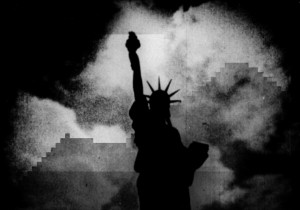The Amazing Logistics of Flexner’s Fieldwork ~ Mark D. Hiatt, MD, MBA
 Originally published in the Medical Sentinel 2000;5(5):167-168.
Originally published in the Medical Sentinel 2000;5(5):167-168.
Copyright © 2000 Association of American Physicians and Surgeons (AAPS).
Dr. Hiatt is a resident in diagnostic radiology at the University of Virginia in Charlottesville, Virginia.
His e-mail is hiatt@medscape.com.
From Jules Verne’s Around the World in 80 Days
Phileas Fogg had won his wager, and had made his journey around the world in eighty days.
To do this he had to employ every means of conveyance — steamboats, railways, carriages, yachts, trading vessels, sleds, and elephants.
The Eccentric gentlemen had throughout displayed all these marvelous qualities of coolness and exactitude. But what then?
What had he really gained by all this trouble?
What had he brought back from this long and wary journey?
 The Flexner Report(1) is one of the most cited evaluations of medical education in the twentieth century. Published in 1910 by the Carnegie Foundation, the Report arose from research conducted by Abraham Flexner, who claimed to have visited and objectively evaluated 155 graduate and twelve postgraduate medical schools in the United States and Canada.
The Flexner Report(1) is one of the most cited evaluations of medical education in the twentieth century. Published in 1910 by the Carnegie Foundation, the Report arose from research conducted by Abraham Flexner, who claimed to have visited and objectively evaluated 155 graduate and twelve postgraduate medical schools in the United States and Canada.
His recommendations have met with high regard in the ensuing nine decades,(2,3) but the underlying research has gone virtually unquestioned. The suspect motives and means behind the Report, as well as its equivocal legacy, have been described elsewhere.(4) This article explores in greater depth the amazing logistics of Flexner’s fieldwork.
Abraham Flexner began his evaluation of North American medical education in December 1908. He first conducted a literature review for one month since he was, by his own admission, a layman with a “very sketchy notion of the main functions of the various departments” of a medical institution(5) who had “never had [his] foot inside a medical school.”(6)
Then, notwithstanding his further concession that he “knew neither anatomy, physiology, nor psychology enough to warrant [his] embarking on a highly specialized bit of experimentation,” Flexner commenced his fieldwork in January 1909, claiming to have visited in the following 16 months each of the 167 institutions he evaluated in accord with a personal maxim Ambulando discimus (“We learn by going about”).(6)
Yet, the quality of this learning is questionable given certain peculiar features of Flexner’s going about. First, Flexner had a large number of institutions (167) to visit and evaluate, and the actual number of site visits (175) was even greater since three schools maintained separate campuses in different cities* and Flexner revisited five other schools in different months.
 Second, the many campuses Flexner had to visit were, of course, scattered about the continent. Third, this logistical challenge of visiting multiple geographically dispersed schools in a limited period of time was further complicated by Flexner’s inclination to return often to his home base in New York, as he disclosed, to “set [his] facts in order.”(6) Finally, a traveler in 1909 would have been much like the fictitious Phileas Fogg of Jules Verne’s Around the World in 80 Days for whom, just a few decades prior to Flexner’s journey, the train — not the airplane — was the fastest available means of transportation. In light of these peculiarities, Flexner’s itinerary contained some periods during which the early twentieth-century traveler had to move at an impressive pace.
Second, the many campuses Flexner had to visit were, of course, scattered about the continent. Third, this logistical challenge of visiting multiple geographically dispersed schools in a limited period of time was further complicated by Flexner’s inclination to return often to his home base in New York, as he disclosed, to “set [his] facts in order.”(6) Finally, a traveler in 1909 would have been much like the fictitious Phileas Fogg of Jules Verne’s Around the World in 80 Days for whom, just a few decades prior to Flexner’s journey, the train — not the airplane — was the fastest available means of transportation. In light of these peculiarities, Flexner’s itinerary contained some periods during which the early twentieth-century traveler had to move at an impressive pace.
Flexner himself admitted that his tour of schools was “swift,” acknowledging that he finished inspections “within less than a year.”(6) Although 16 months — from January 1909 to April 1910 — were allotted to the fieldwork, the majority of the visits occurred in only half of this time: in eight months, Flexner made 157, or 90 percent, of his 175 site visits.
Flexner visited 96 of these schools in his first five months of fieldwork. Specifically, in January 1909, according to footnotes in the Report, Flexner traveled to six states (Alabama, Georgia, Kentucky, Louisiana, Mississippi, and Tennessee) to visit 15 schools.
In the following month (February 1909), he traveled to Georgia, North Carolina, South Carolina, and Virginia to visit 11 schools. In March, he traveled to the District of Columbia, Maryland, Michigan, New York, Ontario, Pennsylvania, Quebec, and West Virginia to visit 22 schools. In April, he traveled to Colorado, Illinois, Iowa, Missouri, Nebraska, and Utah to visit 31 schools.
Finally, in May 1909, he traveled to California, Manitoba, Minnesota, North Dakota, Oregon, Vermont, and Wisconsin to visit 17 schools.
After a four-month rest, Flexner resumed his fieldwork to visit another 61 schools in the ensuing three months. Specifically, in October 1909, he traveled to Maine, Massachusetts, New York, Nova Scotia, Ontario, and Quebec to visit 15 schools.
 In November, he traveled to ten states (Arkansas, Iowa, Kansas, Mississippi, Missouri, New York, Oklahoma, South Dakota, Tennessee, and Texas) to visit 23 schools. Finally, in December, he traveled to Illinois, Indiana, Kentucky, Maryland, Michigan, New York, and Ohio to visit another 23 schools.
In November, he traveled to ten states (Arkansas, Iowa, Kansas, Mississippi, Missouri, New York, Oklahoma, South Dakota, Tennessee, and Texas) to visit 23 schools. Finally, in December, he traveled to Illinois, Indiana, Kentucky, Maryland, Michigan, New York, and Ohio to visit another 23 schools.
What about the other eight months of relative inactivity? For four consecutive months in the summer (June through September 1909), Flexner visited no schools at all; during March and April 1910, he visited one and two schools, respectively; and in January and February 1910, he visited eight and seven schools, respectively.
In eight months, or approximately 240 days, Flexner had to make 157 site visits to geographically dispersed schools. In performing “a slight operation in mental arithmetic” (to borrow a phrase Flexner used to describe how he evaluated the financial aspects of medical education),(6) 240 days for 157 visits yields 1.5 days, on average, to travel to, and comprehensively evaluate, each campus. The pace quickens, however, when one allots time for weekend repose. In excluding Saturdays and Sundays from the 240 days, Flexner would have had only about 180 working days to travel to and evaluate the schools, or 1.1 days, on average, per visit.
Flexner’s pace becomes even more amazing in April 1909, during which he claimed to have investigated 31 schools in six states (Colorado, Illinois, Iowa, Missouri, Nebraska, and Utah), spending about one day for each school. Again, in excluding weekend days, the train-dependent Flexner would have had only a fraction of a day (0.71) per school. Nevertheless, he released his recommendations in June 1910 on the basis of this seemingly rushed research, in spite of the proverb his grandmother had taught him to refrain from leaping to hasty conclusions: So schnell schiessen die Preussen nicht (“The Prussians don’t shoot so hastily”).(6)
 Flexner’s rapid pace seems to conflict with the Report’s assertion that Flexner spared no effort “to procure accurate and detailed information as to facilities, resources, and methods of instruction.”(1) His task was indeed ponderous. Flexner sought data on five points for each of the 167 schools: (1) entrance requirements and adherence to them, (2) the size and training of the faculty, (3) the sum and allocation of endowment and fees to support the institution, (4) the adequacy and quality of the laboratories as well as the training and qualifications of the laboratory instructors, and (5) the relationships between the school and its associated hospitals.
Flexner’s rapid pace seems to conflict with the Report’s assertion that Flexner spared no effort “to procure accurate and detailed information as to facilities, resources, and methods of instruction.”(1) His task was indeed ponderous. Flexner sought data on five points for each of the 167 schools: (1) entrance requirements and adherence to them, (2) the size and training of the faculty, (3) the sum and allocation of endowment and fees to support the institution, (4) the adequacy and quality of the laboratories as well as the training and qualifications of the laboratory instructors, and (5) the relationships between the school and its associated hospitals.
Flexner’s later confession may more accurately reflect the thoroughness and objectivity of his research. He revealed that he used no standard questionnaire and “no fixed method of procedure.”(6) He was also prone to return often to his home in New York to “set [his] facts in order.”(6) Flexner even toured the facilities of some institutions unaccompanied by school officials. At one school, he bribed the janitor to open the laboratories, wherein he failed to find any apparatus, concluding that the school had none without considering the possibility that it could be locked up elsewhere.(6) Flexner visited other schools when they were not even in session.(7) Although such casual observation conflicts with the scientific medicine Flexner claimed to promote, he himself admitted that “[i]nconsistency never bothered [him].”(6)
Abraham Flexner’s evaluation of medical education on the North American continent in the early twentieth century proceeded at a rapid pace. The itinerary that emerges from the footnotes Flexner left in his Report reveals periods during which he would have had only a fraction of a day to travel to and evaluate a school. Either Flexner was strikingly efficient or his efforts lacked thoroughness. In any event, a Report of such repercussions warrants further study of the methods used in its creation. Certainly Flexner, allegedly the promoter of the scientific method in medical education, would have approved of such perusal.
Footnotes
- The University of California maintained “clinical” and “medical” departments in Berkeley and San Francisco, respectively; the American Medical Missionary College, as a “divided school,” maintained separate campuses, “part of the work being done in Chicago, part at Battle Creek”; and Laval University maintained departments in Montreal and Quebec.
- Flexner twice visited four Chicago schools (in April and again in December 1909) and one school in Cincinnati (in December 1909 and April 1910).
- Flexner failed to provide the date of his visit to one of the two Louisiana schools (the Medical Department of the Tulane University of Louisiana). It is assumed that he visited this school in the same month in which he visited the other school in Louisiana.
- Since Flexner did not provide the date of his visit to the Chicago campus of American Medical Missionary College, it is assumed that he visited this campus when he visited the majority of the Chicago schools. He visited the College’s Battle Creek, Michigan campus in February 1910.
1. Flexner A. Medical Education in the United States and Canada: A Report to the Carnegie Foundation for the Advancement of Teaching; Bulletin No. 4. New York: Carnegie Foundation for the Advancement of Teaching; 1910.
2. Bender W. Abraham Flexner – a crusader against medical maleducation. J Cancer Educ 1993;8(3):183-189.
3. Meites S. Abraham Flexner’s legacy: a magnificent beneficence to American medical education and clinical chemistry. Clin Chem 1995; 41(4): 627-632.
4. Hiatt MD. Around the continent in 180 days: the controversial journey of Abraham Flexner. Pharos 1999;62(1):18-24.
5. Flexner A. Henry S. Pritchett: A Biography. New York: Columbia University Press; 1943.
6. Flexner A. Abraham Flexner: An Autobiography. New York, Simon & Schuster, 1960.
7. Felts JH. Abraham Flexner and medical education in North Carolina. NC Med J 1995;56:534-540.

